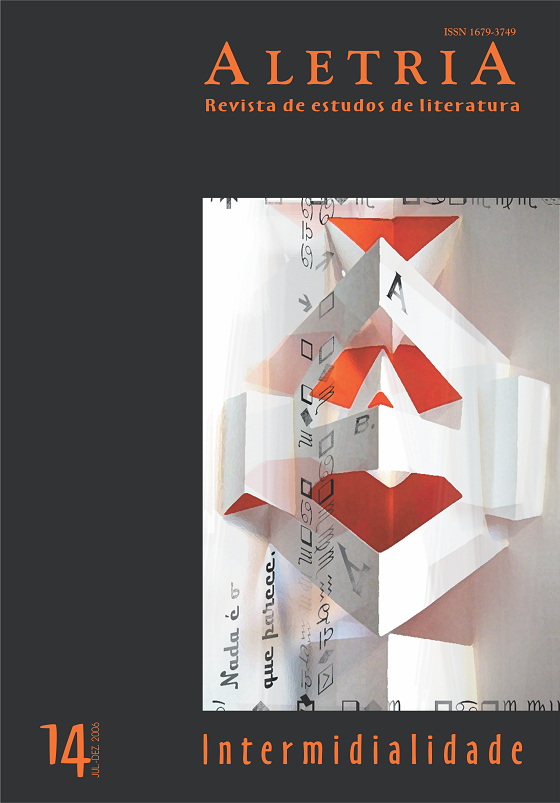Rituals of remembrance: photography and autobiography in postmodern text
DOI:
https://doi.org/10.17851/2317-2096.14.2.246-263Resumo
I argue that the use of photography in postmodern and postcolonial fiction functions firstly, by providing a powerful strategy for drawing attention to the creative and subjective ways in which both verbal and visual images are produced and presented and, secondly, by validating a verbal narrative’s exploration of events as well as supplying a special access to events and experiences that may have been forgotten or unknown. Photography emerges as a unique vehicle for moving between past and present and for thinking photographically as the image of a fleeting moment in time and space is allowed to dissolve into a multitude of possible takes, conflating variousviewpoints and space-times of the past, present and future.
Downloads
Referências
ATKINSON, Kate. Behind the Scenes at the Museum. New York: Picador, 1996.
ATKINSON, Kate. Web Interview. http://www.booksattransworld.co.uk. Downloaded on 5 June 2004.
BAER, Ulrich. Spectral Evidence: The Photography of Trauma. Cambridge, MA: MIT Press, 2002.
BARTHES, Roland. Camera Lucida: Reflections on Photography. Trans. Richard Howard. New York: Hill and Wang, 2000.
BOURDIEU, Pierre. Photography: A Middle-brow Art. Cambridge: Polity Press, 1990.
COLAPIETRO, Vincent. Personal email, 28 July 2005.
HUTCHEON, Linda. Running in the Family: The Postmodernist Challenge. In: SOLECKI, Sam (Org.). Spider Blues: Essays on Michael Ondaatje. Montreal: Véhicule Press, 1985, p. 301-314.
LJUNGBERG, Christina. Diagrams in Narrative: Visual Strategies in Contemporary Fiction. In: MÜLLER, Wolfgang; FISCHER, Olga (Org.). From Sign to Signing. Amsterdam and Philadelphia: Benjamins, 2003, p. 183-199.
LJUNGBERG, Christina. Diagrams and Diagrammatization in Literary Texts. In: VEIVO, Harri (Org.). Peirce and Literary Studies. Recherches Semiotiques / Semiotic Inquiry v. 24, p. 99-115, 2005.
NAKAJIMA, Toshiro. Reading Lewis Caroll’s Alice Lidell as the “Beggar Maid”. Tokyo: Hosei University Press, 2002.
ONDAATJE, Michael. Running in the Family. New York: Vintage, 1993.
PEIRCE, Charles Sanders. Collected Papers of Charles Sanders Peirce. Hartshorne, C.; WEISS, P.; Burks, A. W. (Org.). Cambridge, MA: Harvard University Press, 1931-1958.
RICOEUR, Paul. Life in Quest of Narrative. In: WOOD, David (Org.). On Paul Ricoeur: Narrative and Interpretation. London and New York: Routledge, 1991, p. 20-33.
SANTAELLA, Lucia. The Prephotographic, the Photographic, and the Postphotographic Image. In: Nöth, Winfried (Ed.). Semiotics of the Media: State of the Art, Projects and Perspectives. Berlin and New York: Mouton de Gruyter, 1997, p. 121-132.
SHIELDS, Carol. The Stone Diaries. Toronto: Vintage, 1994.
SHIELDS, Carol. Web Interview. http://www.penguinputnam.com. Downloaded on 20 June 2004.
SLETHAUG, Gordon E. The Coded Dots of Life. Canadian Literature 156, p. 59-81, 1998.
SONTAG, Susan. On Photography. New York: Penguin, 1977.
Downloads
Publicado
Edição
Seção
Licença
Copyright (c) 2006 Christina Ljungberg (Autor)

Este trabalho está licenciado sob uma licença Creative Commons Attribution 4.0 International License.
Autores que publicam nesta revista concordam com os seguintes termos:Autores mantém os direitos autorais e concedem à revista o direito de primeira publicação, com o trabalho simultaneamente licenciado sob a Licença Creative Commons Attribution que permite o compartilhamento do trabalho com reconhecimento da autoria e publicação inicial nesta revista.Autores têm autorização para assumir contratos adicionais separadamente, para distribuição não-exclusiva da versão do trabalho publicada nesta revista (ex.: publicar em repositório institucional ou como capítulo de livro), com reconhecimento de autoria e publicação inicial nesta revista.Autores têm permissão e são estimulados a publicar e distribuir seu trabalho online (ex.: em repositórios institucionais ou na sua página pessoal) a qualquer ponto antes ou durante o processo editorial, já que isso pode gerar alterações produtivas, bem como aumentar o impacto e a citação do trabalho publicado (Veja The Effect of Open Access).














